Arboretum Birds

A total of 211 bird species have been found in the University of Guelph Arboretum (see list below). This 165 hectare area has various habitats including maple/beech forest, old fields, ponds, swamps and beech/hemlock forest, creating many great places to observe birds and other wildlife. No matter what the season, you will find a variety of species on every visit. Want to see what has been seen recently? Click here to see the e-bird hotspot lists.
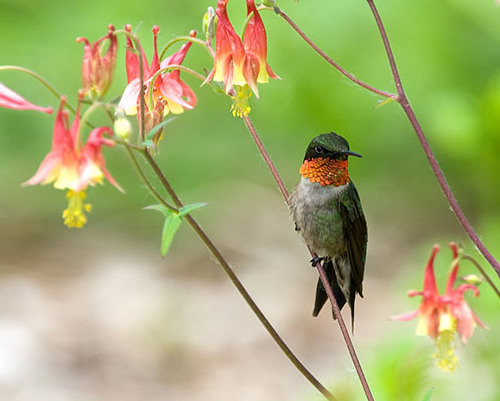
Our Ruby-throated Hummingbirds become quite tame and delight birders and photographers alike. Photo by Jon Brierley.
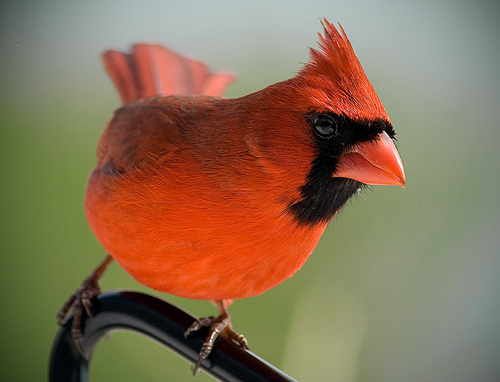
Northern Cardinals are popular with new and experienced birders. Photo by Josh Crozier.
In the list below, the 87 species marked with an * have been known to breed in this site. Those marked with (*) may breed here also. The two species marked with ** are escapees. One species is marked with !; this is the extinct Passenger Pigeon. Historical records indicate that this species may have had a breeding colony along the Speed River close to The Arboretum and thus this species was likely a common sight here long ago.
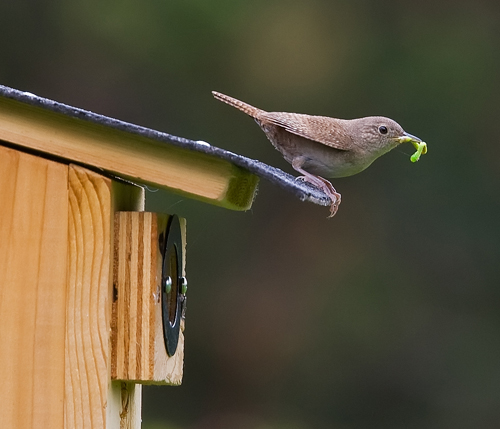
Our many bird boxes attract species such as Eastern Screech-Owls, Tree Swallows, Eastern Bluebirds, Great Crested Flycatchers, Black-capped Chickadees and, of course, House Wrens (shown here). Photo by Marienna Egressy.
We teach a wide variety of bird workshops at The Arboretum; click here to see which ones are coming up! We also sell Feeder Birds of The Arboretum and Summer Garden Birds of The Arboretum booklets .
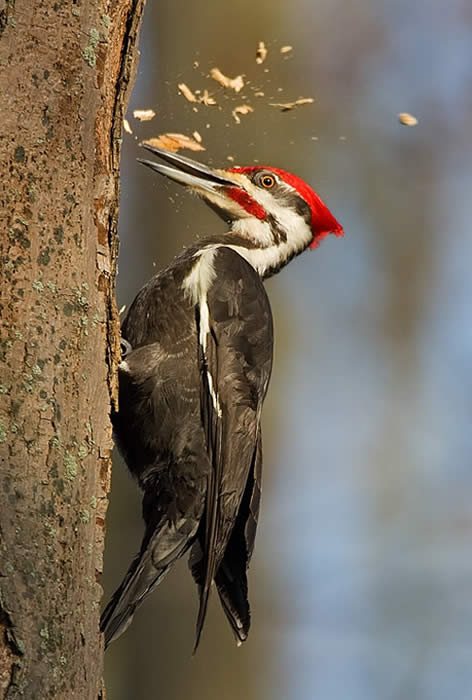
Pileated Woodpeckers often nest in our forests. As you can see, they are efficient at excavating their nesting cavities! Photo by Karl Egressy.
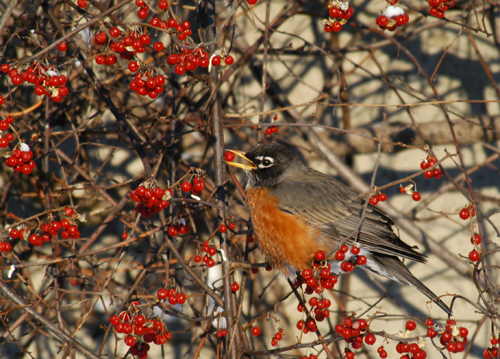
American Robins (shown here), Cedar and Bohemian Waxwings and many other species are attracted to berries in The Arboretum in winter. Photo by Chris Earley.
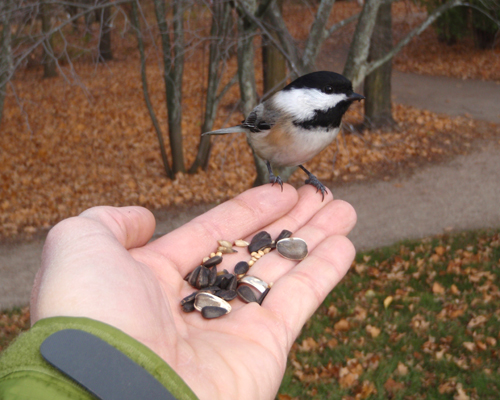
Our Black-capped Chickadees may be enticed to your hand if you stand still enough. Photo by Chris Earley.
Birds of The University of Guelph Arboretum
ANSERIFORMES
Ducks, Geese, & Swans
- Snow Goose
- Cackling Goose
- Canada Goose *
- Tundra Swan
- Wood Duck *
- American Black Duck
- Mallard *
- Blue-winged Teal *
- Green-winged Teal
- Bufflehead
- Common Goldeneye
- Hooded Merganser *
- Common Merganser
- Red-breasted Merganser
GALLIFORMES
New World Quail
- Northern Bobwhite **
Partridges, Grouse, & Turkeys
- Chukar **
- Ruffed Grouse *
- Wild Turkey
PODICIPEDIFORMES
Grebes
- Pied-billed Grebe
COLUMBIFORMES
Pigeons and Doves
- Rock Pigeon
- Mourning Dove *
- Passenger Pigeon
CUCULIOFORMES
Cuckoos & Anis
- Yellow-billed Cuckoo *
- Black-billed Cuckoo *
CAPRIMULGIFORMES
Goatsuckers
- Common Nighthawk
- Whip-poor-will
APODIFORMES
Swifts
- Chimney Swift
Hummingbirds
- Ruby-throated Hummingbird *
GRUIFORMES
Rails, Gallinules, & Coots
- Virginia Rail *
- Sora *
Cranes
- Sandhill Crane
CHARADRIIFORMES
Plovers
- Killdeer *
Sandpipers & Phalaropes
- Spotted Sandpiper
- Solitary Sandpiper
- Greater Yellowleg
- Lesser Yellowlegs
- Wilson's Snipe *
- American Woodcock *
- Upland Sandpiper
Gulls, Turns, & Skimmers
- Franklin's Gull
- Bonaparte's Gull
- Ring-billed Gull
- Herring Gull
- Iceland Gull
- Lesser Black-backed Gull
- Glaucous Gull
- Great Black-backed Gull
- Caspian Tern
GAVIIFORMES
Loons
- Common Loon
SULIFORMES
Cormorants
- Double-crested Cormorant
PELECANIFORMES
Herons & Bitterns
- American Bittern *
- Least Bittern
- Great Blue Heron
- Great Egret
- Cattle Egret
- Green Heron *
- Black-crowned Night-Heron
ACCIPITRIFORMES
Vultures
- Turkey Vulture *
Osprey
- Osprey
Hawks, Kites, & Eagles
- Bald Eagle
- Northern Harrier *
- Sharp-shinned Hawk *
- Cooper's Hawk *
- Northern Goshawk
- Red-shouldered Hawk
- Broad-winged Hawk
- Red-tailed Hawk *
- Rough-legged Hawk
STRIGIFORMES
Typical Owls
- Eastern Screech-Owl *
- Great Horned Owl *
- Snowy Owl
- Barred Owl
- Long-eared Owl *
- Northern Saw-whet Owl
CORACIIFORMES
Kingfishers
- Belted Kingfisher *
PICIFORMES
Woodpeckers
- Red-headed Woodpecker *
- Red-bellied Woodpecker
- Yellow-bellied Sapsucker
- Downy Woodpecker *
- Hairy Woodpecker *
- Northern Flicker *
- Pileated Woodpecker *
FALCONIFORMES
Caracaras & Falcons
- American Kestrel *
- Merlin
- Peregrine Falcon
PASSERIFORMES
Tyrant Flycatchers
- Olive-sided Flycatcher
- Eastern Wood-Pewee *
- Yellow-bellied Flycatcher
- Acadian Flycatcher
- Alder Flycatcher *
- Willow Flycatcher *
- Least Flycatcher
- Eastern Phoebe *
- Great Crested Flycatcher *
- Eastern Kingbird *
Shrikes
- Northern Shrike
Vireos
- Yellow-throated Vireo
- Blue-headed Vireo
- Warbling Vireo *
- Philadelphia Vireo
- Red-eyed Vireo *
Crows & Jays
- Blue Jay *
- American Crow *
- Fish Crow
- Common Raven
Larks
- Horned Lark *
Swallows
- Purple Martin
- Tree Swallow *
- Northern Rough-winged Swallow
- Bank Swallow *
- Cliff Swallow
- Barn Swallow *
Chickadees & Tits
- Black-capped Chickadee *
- Boreal Chickadee
- Tufted Titmouse
Nuthatches
- Red-breasted Nuthatch *
- White-breasted Nuthatch *
Creepers
- Brown Creeper *
Wrens
- Carolina Wren
- House Wren *
- Winter Wren *
- Sedge Wren *
Gnatchatchers
- Blue-gray Gnatcatcher
Kinglets
- Golden-crowned Kinglet
- Ruby-crowned Kinglet
Thrushes
- Veery
- Gray-cheeked Thrush
- Swainson's Thrush
- Hermit Thrush
- Wood Thrush *
- American Robin *
- Eastern Bluebird *
Mockingbirds & Thrashers
- Gray Catbird *
- Northern Mockingbird *
- Brown Thrasher *
Starlings
- European Starling *
Waxwings
- Bohemian Waxwing
- Cedar Waxwing *
Old World Sparrows
- House Sparrow *
Pipits
- American Pipit
Finches
- Purple Finch *
- House Finch *
- Pine Grosbeak
- Red Crossbill (*)
- White-winged Crossbill (*)
- Redpoll
- Pine Siskin
- American Goldfinch *
- Evening Grosbeak
Longspurs & Snow Buntings
- Lapland Longspur
- Snow Bunting
Wood-Warblers
- Blue-winged Warbler
- Golden-winged Warbler
- Tennessee Warbler
- Orange-crowned Warbler
- Nashville Warbler
- Northern Parula
- Yellow Warbler *
- Chestnut-sided Warbler
- Magnolia Warbler
- Cape May Warbler
- Black-throated Blue Warbler
- Yellow-rumped Warbler (*)
- Black-throated Green Warbler
- Blackburnian Warbler
- Pine Warbler *
- Palm Warbler
- Bay-breasted Warbler
- Blackpoll Warbler
- Cerulean Warbler
- Prairie Warbler
- Black-and-white Warbler *
- American Redstart (*)
- Prothonotary Warbler
- Ovenbird
- Northern Waterthrush *
- Connecticut Warbler
- Mourning Warbler (*)
- Common Yellowthroat *
- Hooded Warbler
- Wilson's Warbler
- Canada Warbler
- Yellow-breasted Chat
Sparrows (Emberizids)
- Eastern Towhee *
- American Tree Sparrow
- Chipping Sparrow *
- Clay-colored Sparrow (*)
- Field Sparrow *
- Vesper Sparrow *
- Savannah Sparrow *
- Grasshopper Sparrow *
- Fox Sparrow
- Song Sparrow *
- Lincoln's Sparrow
- Swamp Sparrow *
- White-throated Sparrow (*)
- White-crowned Sparrow
- Dark-eyed Junco
Cardinals & Allies
- Scarlet Tanager
- Northern Cardinal *
- Rose-breasted Grosbeak *
- Indigo Bunting *
Blackbirds
- Rusty Blackbird
- Red-winged Blackbird *
- Bobolink *
- Common Grackle *
- Brown-headed Cowbird *
- Baltimore Oriole *
- Orchard Oriole
- Eastern Meadowlark *
- Western Meadowlark
TOTAL: 212 species